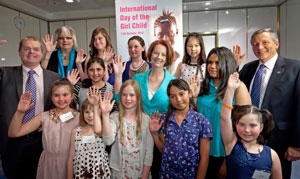Millions of girls around the world face many challenges and barriers in their lives every day–limiting their ability to reach their full potential. In its inaugural year, the UN International Day of the Girl Child (11 October) has been established to help draw the world's attention to these issues.
Australia's primary focus for this year's campaign is education and the tens of millions of girls around the world who are out of school.
The difference education makes to a girl's life is profound. The knowledge and skills they gain help them to build better futures for themselves. They have better access to health care, greater employment opportunities and have the power to make important decisions about their own lives.
An extra year of schooling can boost a girl's future wages by between 10 to 25 per cent. This has flow-on effects in reducing poverty as women typically reinvest 90 per cent of their income in their family, compared to 30 to 40 per cent of men's income.
Prime Minister Julia Gillard launched the UN International Day of the Girl Child at a reception at Parliament House last night. The reception was attended by AusAID Director General Peter Baxter, a number of parliamentarians, diplomats, and representatives of government agencies and domestic organisations for girls and women. The reception was an initiative the Australian Council for International Development, in partnership with Plan International and the UN Information Centre.
What is the Australian aid program doing for girls' education?
Promoting opportunities for all is one of the five strategic goals of Australia's aid program, and Australia is committed to improving the lives of girls in developing countries.
Educating girls and women yields some of the highest returns of all development investments and the Australian Government is committed to playing its part in international efforts to help all children, particularly girls, to attend school for longer and receive better education so they have the skills to build their own future and, in turn, escape poverty.
Australia is helping to improve access to quality education at basic, secondary, technical and tertiary education levels, and particularly to increase the percentage of students who are female. Australia is constructing schools, upgrading classrooms, training teachers and distributing textbooks.
In 2011–12, an estimated $864 million–or approximately 18 per cent of official development assistance–was invested in education. This is an increase from $728 million in 2010–11.
Impressive progress has been made towards achieving Millennium Development Goal 2 (universal education) and Millennium Development Goal 3 (gender equality) in the Asia Pacific, however gender gaps in education still persist.
While most Pacific countries are on track to meet gender targets, Papua New Guinea (PNG) is not. Here, only 84 girls are enrolled in school for every 100 boys. It is projected that the female adult literacy rate in PNG will only be 60 per cent in 2015–severely limiting a woman's ability to effectively participate in society. In 2011, Australia provided financial support for 535,439 school children in PNG attending 5,454 elementary schools.
In Indonesia, Australia is supporting the government to train all school principals to better meet the needs of all girls and boys in the world's fourth largest school system. We have also helped construct or expand approximately 2,000 schools, which has created around 165,000 places for girls.
More Information
- Speech–International Day of the Girl Child [external website]
- United Nations–International Day of the Girl Child [external website]
- Australian Council for International Development (ACFID) [external website]
- PLAN International [external website]
- Asian Forum of Parliamentarians on Population and Development (AFPPD)–Child Marriage in Southern Asia–Policy Options for Action [PDF, external website]
- AusAID working to improve opportunities for all

